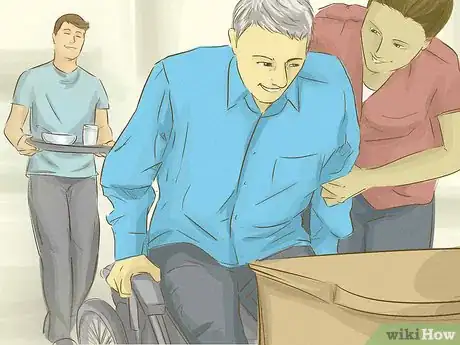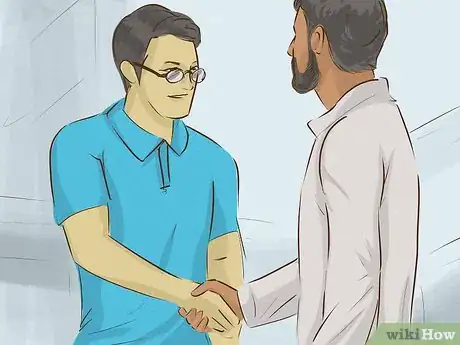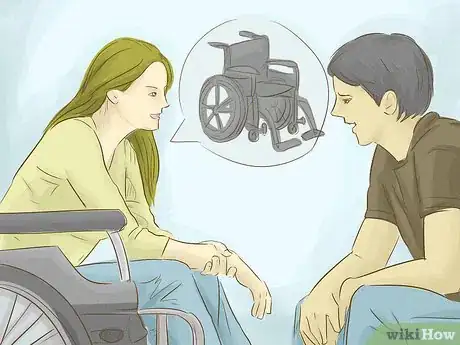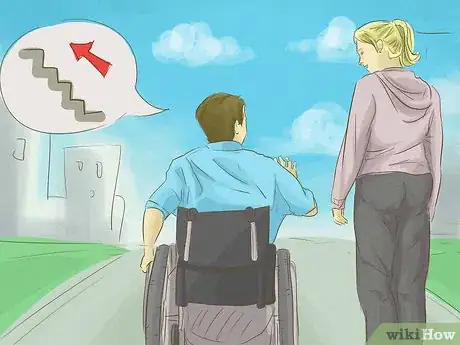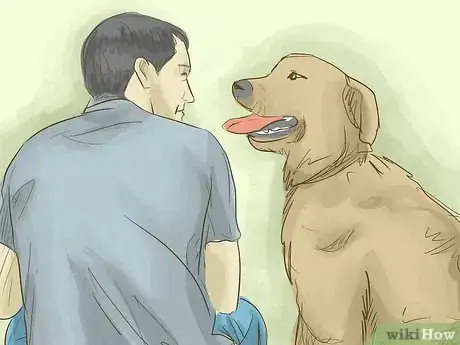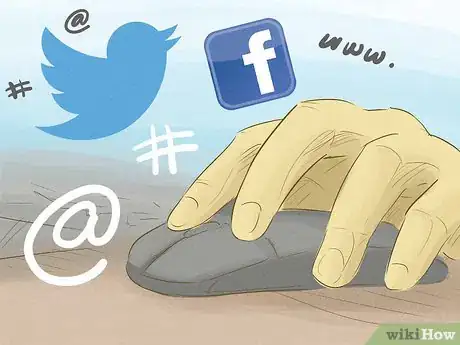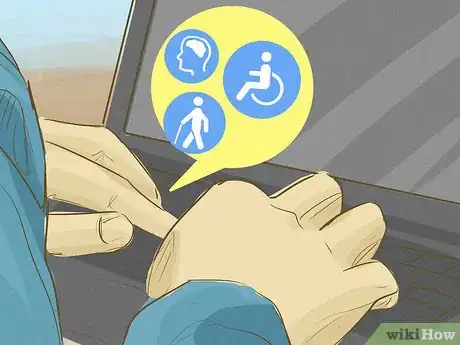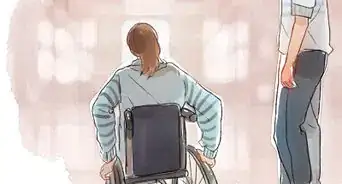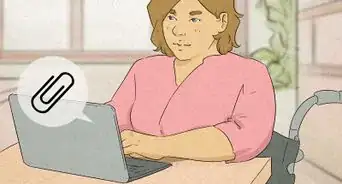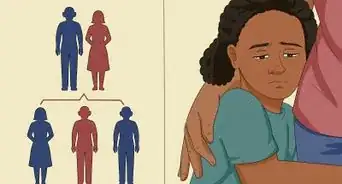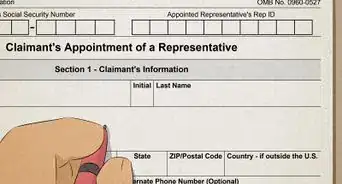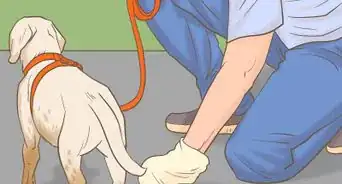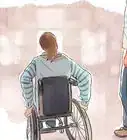This article was co-authored by Trudi Griffin, LPC, MS. Trudi Griffin is a Licensed Professional Counselor in Wisconsin specializing in Addictions and Mental Health. She provides therapy to people who struggle with addictions, mental health, and trauma in community health settings and private practice. She received her MS in Clinical Mental Health Counseling from Marquette University in 2011.
There are 13 references cited in this article, which can be found at the bottom of the page.
wikiHow marks an article as reader-approved once it receives enough positive feedback. This article has 16 testimonials from our readers, earning it our reader-approved status.
This article has been viewed 402,846 times.
A person with a disability is anyone with a physical or mental condition that substantially limits at least one major life activity.[1] If you want to know how to help people with disabilities, there are many routes you can take. Simply learning how to effectively communicate comes first, but you can also offer your services as a volunteer or educator.
Things You Should Know
- When talking to or about people with disabilities, place their personhood before their disability.
- Always be respectful, and ask if someone needs assistance before offering to help.
- Give back to those with disabilities by volunteering, donating money, or helping with accessibility.
- Educate others online or in person so they can support people with disabilities, too.
Steps
Building Communication Skills
-
1Learn the proper terminology. Make sure you use the right terms when discussing people with disabilities. Certain terms that were once considered the norm are now outdated and even offensive. The first step to helping people with disabilities is educating yourself about the right words.[2]
- When speaking about someone with a disability, it's often polite to place their personhood before their specific condition. For example, do not say "mentally ill person" or "the mentally ill." Instead say, "person who has a mental illness." Do not say "wheelchair-bound." Identify them by another means (like you would anyone else), and if you're talking specifically about the use of a wheelchair, say, "person in the wheelchair" or "person who uses the wheelchair." Keep in mind there are a few noteworthy exceptions to this; many people in the Deaf, Blind, and Autistic communities prefer identity-first language, meaning they want to be called an "autistic person" or a "Deaf person" (with the capital D indicating they identify as part of the Deaf culture).[3]
- Certain terms were once considered politically correct are now outdated and can offend. The terms "mute" or "dumb" used to be appropriate for referring to people who cannot speak, but now terms like "nonverbal" or "nonspeaking" are preferred. Lame or crippled were once used to describe those with a physical disability that limited mobility, but now terms like physically disabled are preferred.
- The terms "retarded" and "mentally defective" are considered very offensive by today's standards. Person with an intellectual, developmental, or cognitive disability is the preferred term. While "retarded" was once considered appropriate, as so many people use in a derogatory fashion this is no longer the case. Refrain from using the term in this way, as it's extremely unkind to people with cognitive disabilities.
-
2Communicate directly. Oftentimes, people with disabilities are assisted by interpreters, nurses, or friends during their day-to-day lives. It's important that, when communicating with someone with a disability, you talk directly to that person. Do not filter conversation through someone else.[4]
- Look at the person with a disability, and not their interpreter or assistant. Oftentimes, people who are deaf look to their interpreter while another person talks as they need to do so in order to follow the conversation. You should still look at the person who is deaf, however, as that is who you're communicating with, not the interpreter.
- If you are communicating with someone in a wheelchair, sit down so that they don't strain their neck looking up at you. Avoid bending down like you would to a child; this usually looks awkward.
Advertisement -
3Ask before providing assistance. If you see a person with a disability struggling with something, your first instinct may be to jump in and help. However, without knowing that person's specific needs or intentions you may be doing more harm than good. Always ask before offering your assistance.[5]
- Sometimes, a person with a disability may seem to be struggling when they are actually fine. It may simply take them longer to do certain tasks, but that does not necessarily mean they need a helping hand. If you think they might need help, just ask.
- If you see someone with a disability struggling, simply say "Would you like any help?" or "Do you need assistance?" You do not have to say any more than this.
- If someone declines your offer of assistance, do not be offended or insist on helping. Simply go on with your day. They know their needs better than you do, and pushing them would come off as rude.
- Do not offer medical advice, especially if you are not a doctor. While suggesting yoga for someone with chronic pain may seem helpful, remember that person already has a doctor who knows his specific medical history and giving out advice without solicitation comes off as condescending.[6]
-
4Be respectful in your words and actions. When interacting with someone with a disability, always be respectful in both your words and actions.[7]
- When introduced to someone with a disability, always offer to shake hands. Even someone with limited hand use can usually manage this and refraining from offering a handshake, a typical gesture of courtesy, calls attention to a person's disability.
- Speak in your normal voice and tone. People often feel they should speak slower or louder, especially if they're interacting with a person who is deaf or hard of hearing, but this can come off as rude or infantilizing. Simply talk in your normal voice.
- It is okay to do things to make communication easier. For example, if interacting with someone who is hard of hearing, make sure to look directly at them so they can read your lips and follow other visual cues. Sitting down to make eye contact with someone in a wheelchair can be a polite gesture. If someone has a speech impediment, rather than pretending you understand something they said when you did not you can politely ask them to repeat it.
- Be yourself during any conversation. If you accidentally use a common expression that does not apply, like saying "see you later" to someone who is visually impaired, do not panic and apologize profusely. That person will understand this is a colloquialism and not meant to be taken literally.
-
5Ask questions, if they're relevant. Oftentimes, people worry about inadvertently offending someone with a disability and end up acting off or nervous during interaction. This can be alienating for someone with a disability so be sure to be yourself and stay calm. If you have any questions, it's fine to ask them if they're relevant to the situation.[8]
- For the most part, people with disabilities would rather you simply asked a question politely rather than remaining confused. For example, it's completely appropriate to ask someone who is deaf if they can read lips and would therefore prefer if you faced them each you time you talked. If you're planning an event and you know the wheelchair ramp is in the back room, it's fine to say to someone in a wheelchair, "Do you know where the wheelchair ramp is? It's hard to find, and I just want to make sure you know."
- People are wary to ask questions as they do not want to call attention to someone's disability. However, avoiding an obvious question can sometimes call more attention to the issue than simply addressing it. As long as questions are relevant to the situation at hand, they will likely not come off as prying or insensitive.
Volunteering
-
1Find volunteer opportunities in your area. You can find volunteer opportunities in your community. A variety of organizations strive to provide assistance to people with disabilities.[9]
- Ability First is an organization that provides programs for children and adults with disabilities via employment, recreation, and socialization programs. Ability First has different branches throughout the country and they offer opportunities for volunteers. Depending on the route you take, you may work with people with disabilities hands-on or perform clerical and office duties to help facilities, events, and programs run smoothly. You can browse the Ability First website to find volunteer opportunities in your community.
- The Southern Poverty Law Center has a program called Teaching Tolerance, where an instructor conducts workshops with college and high school students to teach young people how to interact with people with disabilities. You can browse the SPLC's website to see if there's a Teaching Tolerance seminar being conducted in your area and contact the leader to see if they need volunteers for set-up, advertising, or other tasks.[10]
- The United Disabilities services is a non-profit organization that strives to help people with disabilities, including veterans and the elderly, live more independently. They help make homes more accessible, provide medical equipment, custom wheelchairs, and service dogs. The UDS takes volunteers for a variety of fields, from office work to community relations to fundraising and more. While the organization is based in Lancaster, Pennsylvania they do have branches elsewhere.[11]
- You can also look for opportunities through organizations specific to your area. Call local hospitals and nursing homes to ask about where to volunteer or talk to someone you know works professionally with people who are disabled.
- Some organizations, such as Autism Speaks,[12] are considered to do more harm than good. Check with the disability community to make sure it is a good group.
-
2Raise or donate money. Sometimes, fundraising is very helpful. People with disabilities often need extra funds to cover medical costs, home renovations, and other expenses.
- All the organizations listed above periodically conduct fundraisers. Donating money, even a small amount, can help. You can also ask friends and family members to donate as well. If you're having a birthday party, wedding shower, or other big even where it's custom to bring gifts, you could ask for donations instead.
- If you know a disabled person who needs money for an issue related to their disability, you can help that person raise funds. You can throw an event, like a dinner or party, when entry fees are collected to pay for that person's medical costs. You can raise money via online campaigns, using sites like GoFundMe. You can have some kind of contest or raffle, charging submission fees or charging for tickets. There are a variety of ways to raise funds for someone you know in need.
- If you're in school, certain organizations hire college students as fundraisers over the summer months. If you can find an organization that helps people with disabilities, applying for a job fundraising with them can both allow you to help people with disabilities and gain professional experience.
-
3Help with accessibility. Oftentimes, people with disabilities need assistance getting around. You can volunteer to help in this regard.[13]
- If a person's disability means they are unable to drive, you can volunteer to help with transportation. You can either drive someone directly or help people navigate public transportation. Many volunteer organizations recruit people for this purpose specifically.
- Some organizations seek to make the world in general more friendly to people with disabilities related to mobility by installing ramps and other wheelchair-friendly devices in public places. You can help by writing letters to congresspeople, signing petitions, collecting other people's signatures, and raising awareness of buildings or structures that limit access to those with mobility-related disabilities.[14]
-
4Volunteer to train a service dog. If you're a dog person, volunteering to help train a service dog can be a great way to help people with disabilities.[15]
- Service dogs are dogs trained to assist people with cognitive or physical disabilities. Before they can be placed with an owner, they need special training and are usually placed with a volunteer owner until they are 18-months old.[16]
- If you volunteer to raise a service dog, you will be required to attend regular training sessions and train the dog at home in between.[17]
- While training a service dog can be rewarding, it is also a difficult experience. It can be hard to give up a dog or puppy after becoming attached. Make sure you are emotionally prepared to do so before committing to the task.
- This is a great option for college students. First, many colleges students want a pet but cannot commit for too long of a period. Second, university is one of the best ways to socialize a dog as there is such a wide array of activity on campus.
Educating Others
-
1Use social media to your advantage. As so many people actively use social media outlets like Facebook and Twitter, it's easy to spread awareness through such platforms.
- Post links to articles about various disabilities, educating people on a range of physical or cognitive disabilities. Do not just share factual information, however. Provide links to article on how to talk to people with disabilities and how best to help and volunteer.
- If you're tying to raise money or collect signatures for a petition, social media is a powerful tool. Posting links that show people where to donate or sign is the quickest and most convenient way to help your cause.
- Choose articles people are likely to read on their computer or phone. In general, internet users are more likely to select shorter articles, especially those that are in the form of a list or make heavy use of bullet points.
-
2Address prejudice. If you hear people making derogatory comments, intentionally or not, about people with disabilities you should speak up.
- Oftentimes, a person will unintentionally use the wrong word or phrase. If this is the case, you can politely correct. For example, if you hear someone say "Down Syndrome girl" you could say, "Actually, the preferred term is 'girl with Down Syndrome.'"
- The words "retarded" and "retard" are used a lot, even in some forms of media, as a catchall term for something frustrating or otherwise unpleasant. People will often defend their use, saying they do not mean it "in that way" but you can step in here and explain that, regardless of how they mean it, the word carries associations that are hurtful to many.
- If you see discrimination against disabled people happening in a work or school environment, report the discrimination to the proper authorities. If you're unsure who to speak to, you can contact an organization that advocates for disabled people and ask them for advice.
-
3Direct people to the proper resources. Many people do not mean to be hurtful or offensive and are simply unaware of how to interact with people with disabilities. If someone seems confused or uncertain, direct them to relevant websites and organizations that can help them learn how to interact with people disabilities. Education is a powerful tool in fostering social change and creating a more hospitable, tolerant world.
References
- ↑ https://adata.org/faq/what-definition-disability-under-ada
- ↑ https://www.gov.uk/government/publications/inclusive-communication/inclusive-language-words-to-use-and-avoid-when-writing-about-disability
- ↑ http://autisticadvocacy.org/home/about-asan/identity-first-language/
- ↑ https://www.nln.org/education/teaching-resources/professional-development-programsteaching-resourcesace-all/ace-d/additional-resources/communicating-with-people-with-disabilities-e030c45c-7836-6c70-9642-ff00005f0421
- ↑ https://www.nln.org/education/teaching-resources/professional-development-programsteaching-resourcesace-all/ace-d/additional-resources/communicating-with-people-with-disabilities-e030c45c-7836-6c70-9642-ff00005f0421
- ↑ https://www.yahoo.com/health/8-helpful-things-that-dont-really-help-people-117557974473.html
- ↑ https://www.nln.org/education/teaching-resources/professional-development-programsteaching-resourcesace-all/ace-d/additional-resources/communicating-with-people-with-disabilities-e030c45c-7836-6c70-9642-ff00005f0421
- ↑ https://www.respectability.org/inclusion-toolkits/etiquette-interacting-with-people-with-disabilities/
- ↑ https://createthegood.aarp.org/volunteer-ideas/people-with-disabilities.html
- ↑ http://www.tolerance.org/article/disability-awareness-were-it-together
- ↑ http://www.udservices.org/get-involved/volunteer/
- ↑ https://www.psychologytoday.com/blog/aspergers-alive/201311/reporters-guide-the-autism-speaks-debacle
- ↑ https://createthegood.aarp.org/volunteer-ideas/people-with-disabilities.html
- ↑ http://ctb.ku.edu/en/table-of-contents/implement/phsyical-social-environment/housing-accessibility-disabilities/main
- ↑ https://udservices.org/how-to-volunteer-with-people-with-disabilities/
- ↑ http://www.udservices.org/wp-content/uploads/2014/08/Vounteer_ServiceDogs.pdf
- ↑ http://www.udservices.org/wp-content/uploads/2014/08/Vounteer_ServiceDogs.pdf
About This Article
If you want to help people with disabilities, watch for things they seem to struggle with and ask them if they need any help. However, always respect their answer and don’t help them if they don’t want you to. They know what they need and being too insistent can come off as rude. If you want to help more people than you can on your own, try volunteering in your area at places like Ability First or a Teaching Tolerance workshop. You can also volunteer to train a service dog, which usually takes about 18 months. To learn more from our Counselor co-author, like how to use social media to educate others about disabilities, keep reading!

